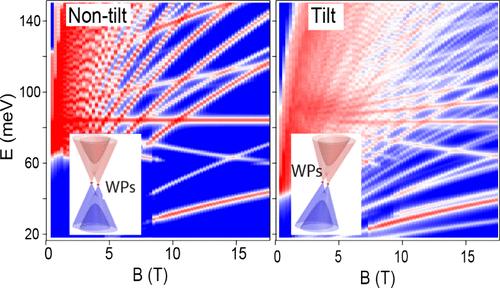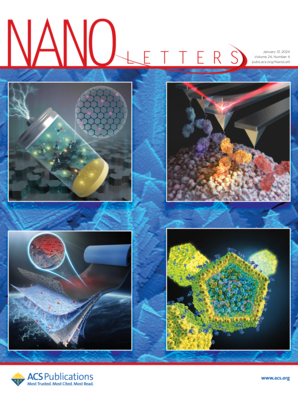Magneto-optical Evidence of the Tilting Effect in Coupled Weyl Bands
IF 9.1
1区 材料科学
Q1 CHEMISTRY, MULTIDISCIPLINARY
引用次数: 0
Abstract
Theories have revealed the universality of the band tilting effect in topological Weyl semimetals (WSMs) and its implications for the material physical properties. However, the experimental identification of tilted Weyl bands remains less explored. Here, we report the magneto-optical evidence of the tilting effect in WSM niobium phosphide. Specifically, we observe Landau level transitions with rich features that are well reproduced within a model of coupled tilted Weyl points. Our analysis indicates that the tilting effect relaxes the selection rules and leads to transitions that would otherwise be forbidden in the non-tilt case. Additionally, we observe unconventional interband transitions with flat and negative magnetic field dispersions, highlighting the importance of coupling between Weyl points. Our results not only emphasize the significance of the tilting effect in the optical responses of WSMs but also demonstrate magneto-optics as an effective tool for probing the tilting effect in electronic band structures.

耦合Weyl波段倾斜效应的磁光证据
理论揭示了拓扑Weyl半金属(WSMs)中带倾斜效应的普遍性及其对材料物理性质的影响。然而,倾斜Weyl带的实验鉴定仍然较少探索。在这里,我们报告了倾斜效应在WSM磷化铌中的磁光证据。具体来说,我们观察到具有丰富特征的朗道能级跃迁,这些特征在耦合倾斜Weyl点的模型中得到了很好的再现。我们的分析表明,倾斜效应放松了选择规则,并导致了在非倾斜情况下被禁止的过渡。此外,我们观察到具有平坦和负磁场色散的非常规带间跃迁,突出了Weyl点之间耦合的重要性。我们的研究结果不仅强调了倾斜效应在wsm光学响应中的重要性,而且证明了磁光学是探测电子能带结构中倾斜效应的有效工具。
本文章由计算机程序翻译,如有差异,请以英文原文为准。
求助全文
约1分钟内获得全文
求助全文
来源期刊

Nano Letters
工程技术-材料科学:综合
CiteScore
16.80
自引率
2.80%
发文量
1182
审稿时长
1.4 months
期刊介绍:
Nano Letters serves as a dynamic platform for promptly disseminating original results in fundamental, applied, and emerging research across all facets of nanoscience and nanotechnology. A pivotal criterion for inclusion within Nano Letters is the convergence of at least two different areas or disciplines, ensuring a rich interdisciplinary scope. The journal is dedicated to fostering exploration in diverse areas, including:
- Experimental and theoretical findings on physical, chemical, and biological phenomena at the nanoscale
- Synthesis, characterization, and processing of organic, inorganic, polymer, and hybrid nanomaterials through physical, chemical, and biological methodologies
- Modeling and simulation of synthetic, assembly, and interaction processes
- Realization of integrated nanostructures and nano-engineered devices exhibiting advanced performance
- Applications of nanoscale materials in living and environmental systems
Nano Letters is committed to advancing and showcasing groundbreaking research that intersects various domains, fostering innovation and collaboration in the ever-evolving field of nanoscience and nanotechnology.
 求助内容:
求助内容: 应助结果提醒方式:
应助结果提醒方式:


